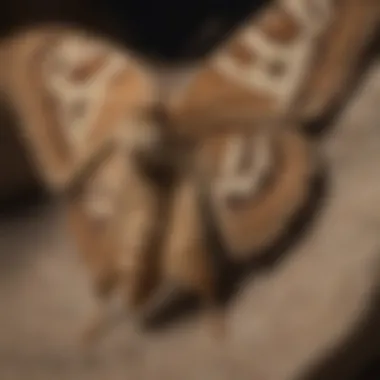Effective Ways to Shield Your Clothes from Moths


Intro
Moths are more than just a small nuisance; they can do significant damage to your beloved garments if left unchecked. Understanding how to fend off these unwanted guests is crucial for preserving your wardrobe's integrity. The process involves not only recognizing the signs of a moth infestation but also implementing effective prevention strategies and storage practices. This guide will delve into the lifecycle of moths, their habits, and the various methods available to protect your clothing.
Understanding Moths and Their Lifecycle
Moths that target clothing are often the larvae that do the damage. Adult moths lay eggs on fabrics, particularly those made from natural fibers. Once the larvae hatch, they start munching on your clothes, creating holes that can turn your stylish wardrobe into a wardrobe in shambles.
To get a handle on this problem, it’s essential to learn about the two most common species: the common clothes moth and the case-bearing moth. The former prefers dark and undisturbed areas, while the latter is often found in dusty corners or places stuffed with fibers and debris.
"An ounce of prevention is worth a pound of cure."
Effective Prevention Strategies
Regular Cleaning
One of the best defenses against moths is keeping your clothing clean. Dirty clothes, especially those with food particles or perspiration, can attract moths. Regularly washing your clothes, particularly seasonal items, ensures that no hunger pangs lead them to your closet. Moreover, dry cleaning can be an effective method for items that are especially vulnerable, such as wool suits or cashmere sweaters.
Use of Natural Repellents
Another strategy is employing natural repellents like lavender, cedar, or rosemary. Placing sachets filled with dried lavender flowers or using cedar blocks in your wardrobe not only acts as a pleasant scent but also deters moths. Cedar releases natural oils that moths find unappealing, thus helping to keep them at bay.
Monitor Your Closet
Keep an eye on your closet space. Regular inspections can help identify any signs of moth activity before they become a bigger problem. Look for tiny holes in fabrics, webbing, or shed skin of larvae. Taking action at the first signs could save you a lot of grief later on.
Efficient Storage Methods
Seasonal Storage
When it comes to seasonal clothing, proper storage methods are key. Here are some tips for effective clothing storage:
- Use breathable cotton or fabric bags instead of plastic, which can trap moisture and create a breeding ground for mold and moths.
- Ensure everything is clean and completely dry before storing. Any dye or residue can attract unwanted pests.
- Consider vacuum-sealing items to eliminate air and moisture, making it less conducive for moths to thrive.
Organizing Your Wardrobe
Another practical measure is the organization of your wardrobe. Keep items that you don’t wear often sealed away from more frequently used clothes. This not only makes it harder for moths to access everything but also allows you to rotate items more easily.
By following the outlined strategies, you can enjoy peace of mind rather than worry over unwelcome, destructive visitors in your closet.
Understanding Moths and Their Impact
In the grand tapestry of clothing preservation, understanding the little culprits known as moths is crucial. These minuscule pests pack a punch, causing significant damage to wardrobes worldwide. Delving into their habits, lifecycle, and impact on our prized garments allows homeowners and design enthusiasts to take a proactive stance against them. The cost of neglecting this knowledge can lead to unsightly holes and irreparable damage.
Types of Moths That Damage Clothes
When it comes to clothing destruction, not all moths are created equal. The primary offenders include the Common Clothes Moth and the Webbing Clothes Moth. Both species are a part of the Tineidae family, and they thrive in dark, undisturbed environments like closets and wardrobes.
- Common Clothes Moth: These are small, buff-colored moths that are visible during their adult stage. They tend to lay eggs on fabric, where the larvae then feed on keratin—a protein found in animal fibers such as wool, silk, and cashmere.
- Webbing Clothes Moth: Slightly different, these moths can often be spotted by their unique webbing created in areas where they infest. They can cause extensive damage as they feast on the fibers.
Recognizing these moths can help tailor your prevention strategies effectively and keep your closet safe from destruction.
Lifecycle of the Clothes Moth


Grasping the lifecycle of clothes moths is like uncovering their playbook. These insects undergo four stages: egg, larva, pupa, and adult. Each stage plays a role in the potential havoc they can wreak on clothing.
- Egg Stage: Females lay dozens of eggs on or near fabrics. This can happen in just a matter of days under optimal conditions.
- Larva Stage: Upon hatching, the larvae begin to munch away on your fabrics, and this is where the real trouble begins. This stage can last several weeks to months, depending on environmental conditions.
- Pupa Stage: After they've had their fill, the larvae spin themselves into a cocoon, transitioning into the pupa stage. This stage can last weeks.
- Adult Stage: Finally, they emerge as adult moths, ready to mate and continue the cycle.
It's indisputable: larvae are the true culprits – they’re the ones causing serious damage while adults are merely looking for mates.
Signs of a Moth Infestation
So, how do you spot these pesky invaders before they turn your beloved wardrobe into their buffet?
- Fabric Damage: Look for irregular holes in clothing, particularly in natural fibers. This is often the first sign one might notice.
- Larvae and Webs: If you stumble upon tiny caterpillars or silk webbing inside your closet, it’s a red flag indicating a thriving colony.
- Moth Soylunk Excrement: Small, brown specks resembling pepper or coffee grounds might litter your fabric or closet floors. This is the waste of the feeding larvae.
- Adult Moths: Spotting adult moths fluttering about is another clear sign of an infestation, signaling that you should act fast.
Understanding these indicators can be invaluable. Early detection is key; it allows homeowners to tackle the problem before it spirals out of control.
By understanding these various elements related to moths, from the types that damage clothes, their lifecycle, and the signs of their presence, homeowners can build a solid foundation for a moth-proof strategy. The knowledge gained here not only equips you to protect your clothes but also fosters an overall sense of control and assurance in your living spaces.
Preventive Measures for Wardrobe Protection
Taking steps to protect your wardrobe from moth damage is essential for preserving not just the fabric but also the memories attached to each piece of clothing. Damages caused by moths can be frustrating and costly, making it necessary to implement preventive measures consistently. Preventive measures serve as the first line of defense against these pesky intruders. By being proactive, you can thwart potential infestations before they escalate into a full-blown problem, ensuring that your clothes remain intact and your wardrobe stays enjoyable.
Regular Cleaning of Clothes
Keeping your clothes clean is more than a matter of aesthetics; it’s a crucial preventive step against moth damage. Dust, sweat, and food particles left on fabrics can serve as attractive meals for moth larvae. Even lightly soiled garments can attract these pests. Here's what you can do:
- Wash regularly: Fabrics that require washing should be laundered frequently, using the hottest water safe for the material.
- Dry clean when necessary: For items that can’t be thrown in the washing machine, consider a professional clean. This is especially true for high-end pieces.
- Inspect clothing regularly: As you clean, take the time to examine items for signs of eggs or larvae. This vigilance can prevent a larger infestation later on.
Proper Storage Techniques
Storing clothes correctly is fundamental to keeping moths at bay. Improper storage can create ideal conditions for moths to thrive. To avoid this, consider these techniques:
- Use airtight containers: When storing off-season clothing, opt for plastic bins with tight seals. This helps eliminate opportunities for moths to gain entry.
- Avoid cardboard boxes: Moths can chew through cardboard, making it an ineffective storage solution. Instead, rely on sturdier options.
- Hang items strategically: For garments that you hang, use padded hangers to maintain shape and reduce wear. Also, ensure there's enough space between items for adequate air circulation.
Using Natural Repellents
Natural repellents can be a game-changer in keeping moths away from your clothes. Many homeowners prefer them over chemical alternatives for their safety and pleasant aromas. Here are some effective options:
- Lavender: Its scent is pleasing to humans but makes moths feel unwelcome. Consider placing sachets of dried lavender in your drawers or closets.
- Cedar: Not just a pretty wood, cedar has natural oils that deter moths. Cedar blocks or chips can be placed with stored items to keep them safe.
- Mint leaves: Crushed mint leaves can also help repel moths. Placing them in small sachets among your clothes can add a fresh scent alongside protection.
Humidity Control in Storage Areas
The environment where clothes are stored plays a huge role in moth prevention. Moths prefer humid conditions, which can lead to issues with not just moths but also mold or mildew. Here are some strategies to maintain an optimal storage environment:
- Use a dehumidifier: If your space is damp, a dehumidifier can significantly reduce moisture levels, making it less inviting for moths.
- Air out frequently: Open up closet doors and storage bins regularly to let fresh air circulate, helping to keep humidity in check.
- Check for leaks: Inspect storage areas for signs of water damage or leaks, and address any issues promptly to prevent inviting pests to stick around.
Remember: Prevention is always cheaper than dealing with an infestation later. Ensuring that you practice these preventive measures will save you both time and money in the long run.
Identification and Treatment of Infestations
Identifying and treating moth infestations draws a crucial line in the sand between a healthy wardrobe and a ruined collection of cherished garments. It’s not simply about spotting a little bug here and there; it’s about understanding the whole situation. The sooner you can recognize the signs of a moth problem, the better equipped you’ll be to act. This section aims to shed light on how to pinpoint a moth infestation, strategies to treat it effectively, and the points at which bringing in the professionals is necessary.
How to Identify a Moth Problem
Identifying a moth problem is often like looking for a needle in a haystack. Moths tend to stay hidden, making it challenging to catch them in the act. But don’t lose heart; there are signs you can look for that will tip you off.


First off, check your clothes regularly, particularly items made of wool, silk, or feathers. Look for small holes and fraying edges. If you notice tiny specks of debris or larvae, you might just have a problem.
Common Signs to Watch Out For:
- Silken Webbing: Moths often leave behind silky threads, particularly in infested fabrics.
- Larvae: Often found in dark corners or crevices, these little caterpillars can be a telltale sign.
- Adult Moths: You may spot the adult moths fluttering around, especially at dusk.
When you notice any of these signs, it’s time to spring into action. Try not to put your head in the sand, as delaying might make matters worse.
Effective Treatments for Moth Infestations
Once you’ve confirmed an infestation, it’s game time. The key focus should be on effective treatments. You want to act swiftly and decisively.
- Washing: Start with washing all affected clothes in hot water. This method not only removes the moths but also eliminates their eggs. Hot steam is particularly effective, so if you can use a dryer, even better.
- Freezing: For those delicate items that can’t withstand heat, freezing can be a lifesaver. Place the clothes in a plastic bag and leave them in the freezer for at least 72 hours.
- Vacuuming: A thorough vacuum of your closets and storage areas can significantly reduce the moth population. Ensure to dispose of the vacuum bag immediately, and clean your vacuum regularly.
Your next step is to determine the right balance of treatments that address both adult moths and any potential eggs. Several over-the-counter treatments exist, but keep in mind that not all are created equal. Look for products that specifically target moths and enhance their efficacy by following instructions closely.
When to Seek Professional Help
If you’ve tried the DIY approach but the situation isn’t getting a handle on, it may be time to call in the experts.
Considerations for Professional Assistance:
- Severe Infestation: An overwhelming presence of adult moths or larvae suggests that they have taken firm root in your home.
- Different Types of Moths: If you suspect there are multiple species causing havoc, professionals can accurately identify them and tailor treatments.
- Damage Control: If damage to your clothes is extensive, it might be worth the expense for a professional extermination service, not to mention the peace of mind.
Remember, an ounce of prevention is worth a pound of cure. Getting ahead of a moth issue can save a lot of time, money, and emotional distress in the long run.
By tackling identification and treatment swiftly, you can safeguard your clothes and keep your wardrobe in tip-top shape.
Natural Solutions to Keep Moths Away
Keeping clothes safe from moth damage can be tricky, but natural solutions hold promise not only for repelling these pests but for enhancing the overall ambiance of your living spaces. Many homeowners often seek methods that aren’t chemically harsh yet still effective. Natural repellents can achieve this balance, gracefully warding off moths while keeping your environment fresh and inviting.
When opting for these solutions, consider the added benefits of aromatherapy. Many essential oils and plant materials not only deter moths but can simultaneously refresh a room. Thus, employing these methods often serves a dual purpose, providing a solution to both aesthetics and functionality. Let's delve deeper into specific natural techniques.
Essential Oils with Moth-Repelling Properties
Essential oils have gained traction in the home care industry, particularly for their aromatic and pest-repellent qualities. Oils such as lavender, rosemary, and peppermint stand out due to their potent fragrances, which moths find unappealing. Using these oils can create a defensive barrier against these unwanted visitors.
To put these oils to practical use, consider creating a simple spray by mixing about 10 drops of your chosen essential oil with water in a spray bottle. Lightly mist areas prone to moths, such as the insides of wardrobe and drawers, while also ensuring proper ventilation. Additionally, you can saturate cotton balls with the oil and place them in strategic locations—drawers, closets, or even in your luggage. This strategy not only helps keep moths at bay but also adds a pleasant scent to your spaces.
The Efficacy of Cedar Chips
Cedar chips have a long-standing reputation as a moth deterrent. The natural oils in cedar wood emit properties that repel common moth species, making it an excellent addition to any storage area. Not only are they effective, providing a layer of protection, they also add a rustic charm to your home.
When utilizing cedar chips, one can place them in sachets or small bags, strategically positioned within your clothes storage. The chips need to be refreshed occasionally; a quick sanding or replacement can ensure they maintain their potency. It's also wise to create a cedar closet or line drawers with cedar planks, adding both a visually appealing aspect and a robust barrier against moths.
Cedar has been proven effective for ages in both repelling pests and creating a pleasant scent!
Herbal Repellents and Their Application
Herbal repellents present another fascinating avenue to explore. Various herbs naturally discourage moths while imparting delightful aromas. Common choices include thyme, mint, and bay leaves, which can be easily incorporated into your storage practices.
To use these herbs effectively, consider creating DIY sachets. Take dried herbs and place them in small cloth bags; these can then be tucked into your closets and drawers. While their scent tends to dissipate over time, replenishing them every few months will keep their effectiveness intact. Moreover, the visual aspect of the sachets can add an organic touch to your wardrobe organization.


In summary, natural solutions to keep moths away not only offer a friendly approach to pest control but also enhance the aesthetic and olfactory appeal of your home. By incorporating essential oils, cedar chips, and various herbs, you can create a multi-faceted defense system against moth infestations. Each method adds its unique charm to your clothes storage, ensuring both protection and pleasant living environments.
Long-Term Strategies for Moth Management
Managing moths requires more than just action in the moment; it's about fostering a robust approach to keep your clothes safe in the long run. The essence of long-term strategies is being proactive rather than reactive. It encompasses a collection of habits and practices that can drastically reduce the likelihood of moths making your wardrobe their home. By institutionalizing preventive measures, you create an environment hostile to these pests.
Implementing these strategies not only protects your garments but also promotes a healthier storage area. A moth-free environment is aesthetically pleasing, allowing you to confidently open your closet without fear of uninvited guests.
Routine Monitoring of Wardrobe
One of the cornerstones of moth management is regular monitoring of your wardrobe. It's not enough to simply clean and store clothing; you need to check for signs of life periodically. This involves more than just a casual glance.
- Frequent Inspections: Schedule inspections every few months. Focus on high-risk areas like dark corners or spots where clothes are densely packed.
- Identify Signs: Look for actual moths, eggs, or even the telltale signs of tiny holes in your fabric.
- Stay Organized: Keep your clothes organized. When everything has a designated spot, you are more likely to notice anomalies.
Just like checking the oil in your car, this routine can save you trouble down the road. Staying alert means you can address any issues before they spiral out of control.
Integrating Moth Prevention in Seasonal Cleaning
The change of seasons marks a perfect opportunity for thorough cleaning coupled with moth prevention techniques. Think of it as an annual ritual to refresh your wardrobe.
- Storage Switching: As seasons change, switch clothing accordingly. Store away summer clothes in airtight containers while allowing room for winter gear, which moths tend to target due to the natural fibers.
- Cleaning Before Storing: Make sure any item you put away is freshly cleaned. Any food particles or perspiration can attract pests.
- Use Natural Repellents: Consider tossing in some lavender sachets or cedar chips into storage. These natural repellents smell good and work wonders in keeping moths at bay.
Integrating moth prevention into your seasonal cleaning not only maintains a clutter-free space but also establishes a vigilant atmosphere for your clothing collection.
Creating a Moth-Free Environment
Creating a moth-free environment encapsulates a series of actions tailored to deter infestation. Here are some specific strategies:
- Good Air Flow: Ensure your closets and storage areas have good airflow. Moths thrive in confined, humid spaces.
- Inspect New Purchases: Always inspect new clothes or linens before adding them to your collection. Moths can hitchhike on new items, bringing trouble at the worst possible time.
- Control Light and Humidity: Moths dislike light, so keeping areas well-lit can help deter them. Aim for lower humidity levels, as damp spaces can invite these pests in.
By implementing these long-term strategies, you create a well-defended barrier against moths. Your proactive planning today ensures your beloved garments are preserved and protected for years to come.
"An ounce of prevention is worth a pound of cure."
In the grand picture, being vigilant in your approach to moth management can reduce the risk of infestation significantly, leaving you free to enjoy your wardrobe.
Closure
In the realm of wardrobe preservation, the significance of preventing moth damage cannot be overstated. The economic and emotional toll of losing cherished garments can be quite heavy, therefore taking action early is paramount. This article has traversed various strategies to combat moth infestations through prevention, identification, and effective treatment.
By understanding the lifecycle of moths and employing proactive measures, homeowners can avert potential disasters. It’s about preserving not just fabrics but the memories and value tied to them. The benefits of these approaches include not only the protection of clothing but also fostering a more organized and mindful living space.
Recap of Key Points
Recapping the critical elements discussed:
- Identifying moth types is crucial to determine the right strategy for prevention.
- Consistent cleaning and proper storage methods are effective first lines of defense against muff creativity.
- Recognizing signs of infestation early can save time, money, and frustration.
- Natural repellents can serve as a safeguard that is gentle on both clothes and the environment.
- Monitoring and integrating moth prevention into seasonal activities helps maintain vigilance.
These points form the core strategies that any homeowner can adopt to keep their treasured clothes safe from the ravages of moths.
The Importance of Proactive Measures
Proactivity in moth prevention is not merely an option; it's a necessity. Waiting for signs of infestation may mean a rude awakening when costly damage is already done. By establishing routines around clothing maintenance and storage, you stand a much better chance of interrupting the cycle of moth activity.
The old saying "an ounce of prevention is worth a pound of cure" rings particularly true here. Taking time to integrate simple actions into your lifestyle can lead to a long-lasting impact on your wardrobe.
- Regular cleaning of clothes helps to eliminate moth eggs and larvae before they become a problem.
- Using natural repellents regularly enhances the protective measures.
- Learning to identify the early signs of an infestation could thwart any potential havoc before it escalates.
By making these efforts part of your norm, you not only protect your garments but also create a more enjoyable home environment. Moths thrive on neglect, so the more you lean into preventive methods, the less likely it is this uninvited nuisance will disturb your peace.







